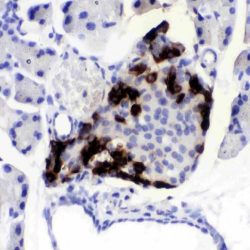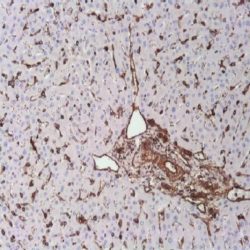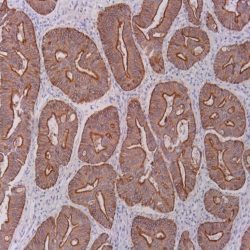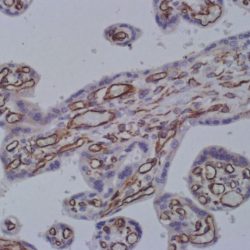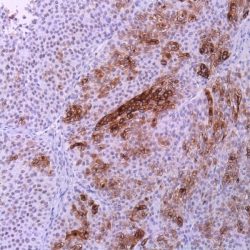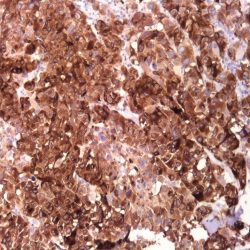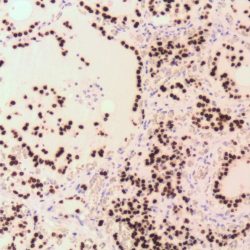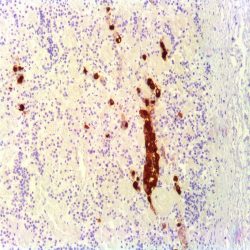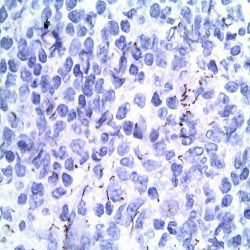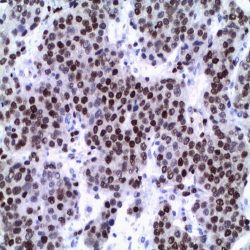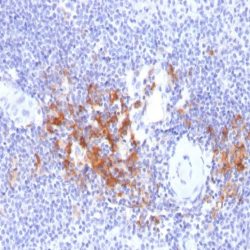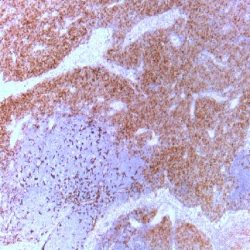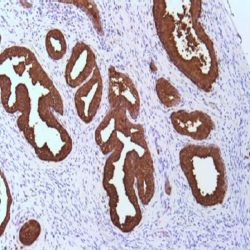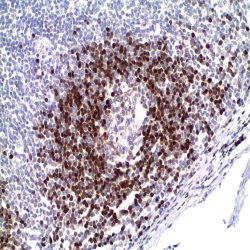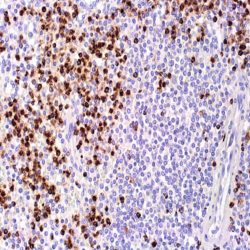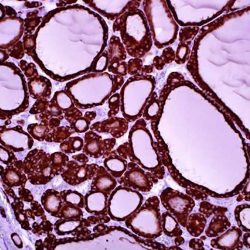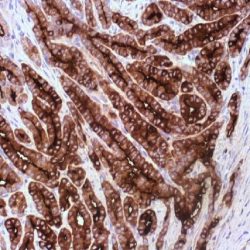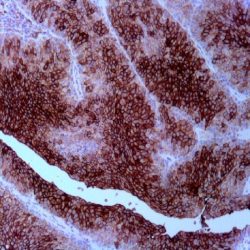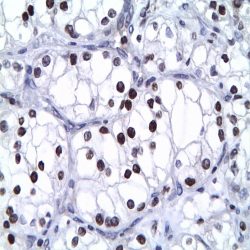دسته: آنتی بادیهای ایمونوهیستوشیمی
نمایش 61–80 از 1002 نتیجه
فیلتر ها-
آنتی بادیهای ایمونوهیستوشیمی
آنتی بادی VIP (H-6)
نمره 0 از 5.(Name: VIPAntibody(Clone H-6
Description and applications: Glucagon is a pancreatic hormone that functions as an antagonist to Insulin, stimulating the conversion of glycogen to glucose and increasing blood sugar levels. Glucagonlike peptide-1 (GLP-1), glucagon-like peptide-2 (GLP- 2), VIP (vasoactive intestinal peptide) and PACAP (pituitary adenylate cyclase activating polypeptide) are members of the glucagon family of hormones. GLP-1 functions as a transmitter in the central nervous system, inhibiting feeding and drinking behavior, whereas GLP-2 is a stimulator of intestinal epithelial growth. VIP causes vasodilation resulting in the lowering of blood pressure. PACAP is abundant in the hypothalamus and has been shown to increasethe synthesis of several hormones, including growth hormone.
Composition: Anti-human VIP mouse monoclonal antibody purified from serum and prepared in PBS with < 0.1% sodium azide and 0.1% gelatin.
Immunogen: Antibody raised against amino acids 1-95 of vasoactive intestinal peptide VIP of human origin.
-
آنتی بادیهای ایمونوهیستوشیمی
آنتی بادی Vimentin (SP20)
نمره 0 از 5.(Name: Vimentin Antibody (Clone SP20
Description and applications: Vimentin is the main intermediate filament protein in mesenchymal cells and is therefore of value in the differential diagnosis of undifferentiated neoplasms. In mesenchymal tumors, vimentin expression is practically the rule, though, it must not forget that there are epithelial tumors that coexpressed Vimentin and cytokeratins, such as thyroid gland carcinomas, pleomorphic adenomas salivary of the salivary glands and some renal carcinomas. Furthermore, by the universal staining the anti-vimentin antibody in the blood vessels and lymphoid tissue, they are considered the best internal control to assess the results of immunostaining.
Composition: anti-human Vimentin, rabbit monoclonal antibody purified from culture supernatant, prepared in 10mM PBS, pH 7.4, with 0.2% BSA and 0.09% sodium azide.
Immunogen: Recombinant protein encoding human vimentin.
-
آنتی بادیهای ایمونوهیستوشیمی
آنتی بادی Villin-1 (CWWB1)
نمره 0 از 5.(Name: Villin-1 Antibody (Clone CWWB1
Description and applications:Villin is a tissue-specific protein with a molecular massAnti-villin monoclonal antibody (CWWB1 clone) against the human antigen has a sensitivity of almost 100% and high specificity; thus, immunostaining is fully reproducible using standard amplification and development procedures performed as part of automated immunostaining systems. Villin is expressed in the brush border of enterocytes and kidney proximal tubule cells. In addition to allowing immunohistochemical identification of villin in normal human tissues, this antibody is a highly specific marker of gastrointestinal tumours and pancreatic cancer. Although with less sensitivity, renal, hepatic and pulmonary neoplasms, especially carcinoid tumours, neuroendocrine tumours and signet-ring cell carcinomas or carcinomas with microlumens filled with microvilli, as well as some breast and ovarian tumours, are also stained. of 95.5 kDa. Of all proteins belonging to the gelsolin family, it is the only one capable of assembling and disassembling actin filaments through three specific binding domains, two of them Ca2+-dependent. Villin is essential for the assembling of the cell brush border citoskeleton and the organization of the actin filament bundle forming the core of microvilli. In addition, it has been proposed that this protein, due to its dependence on cell activation via phosphatidylinositol, is essential for the control of cell polarity during embryonic development of tissues containing it, as well as to facilitate epithelial plasticity in response to cell injury and immune system cell elements migration through the intestinal barrier.
Composition:Anti-human Villin-1 mouse monoclonal antibody purified from serum and prepared in 10mM PBS, pH 7.4, with 0.2% BSA and 0.09% sodium azide.
Immunogen:uman villin protein.
-
آنتی بادیهای ایمونوهیستوشیمی
آنتی بادی VEGF (Vascular Endothelial Growth Factor)(EP1176Y)
نمره 0 از 5.(Name: VEGF (Vascular Endothelial Growth Factor)Antibody (Clone EP1176Y
Description and applications: Growth factor active in angiogenesis, vasculogenesis and endothelial cell growth. Induces endothelial cell proliferation, promotes cell migration, inhibits apoptosis and induces permeabilization of blood vessels. Binds to the FLT1/VEGFR1 and KDR/VEGFR2 receptors, heparan sulfate and heparin. NRP1/Neuropilin-1 binds isoforms VEGF-165 and VEGF-145. Isoform VEGF165B binds to KDR but does not activate downstream signaling pathways, does not activate angiogenesis and inhibits tumor growth.
Composition: anti-human VEGF Rabbit monoclonal antibody purified from ascites fluid by Protein A chromatography prepared in 10mM PBS, pH 7.4, with 0.2% BSA and 0.09% sodium azide.
.Immunogen: Synthetic peptide corresponding to residues on the C-terminus of human VEGF
-
آنتی بادیهای ایمونوهیستوشیمی
آنتی بادی Uroplakin III (BC17)
نمره 0 از 5.(Name: Uroplakin III Antibody (Clone BC17
Description and aplications: This antibody detects the Uroplakin III, a glycoprotein of 47 kDa that forms the asymmetric part of the membrane plates unit constituting the apical surface of the urothelial cell surface or “umbrella cells”. In non-neoplastic cells the uroplakin III is detected exclusively in the normal urothelium of the bladder, ureter and renal pelvis. The antibody stains the luminal surface of the plasma membrane of the “umbrella cells” and weakly in the cytoplasm of some of these cells and some deeper isolated urothelial cells. In tumors, Uroplakin III is detected in 60% of primary urothelial carcinomas and up to 53% of metastases (sensitivity 0.57). Brenner tumors of the ovary also show immunoreactivity for Uroplakin III, the remaining non-urothelial neoplasms being negative (specificity 1.00). Markers such as Uroplakin III, p63, thrombomodulin and GATA3 are expressed in a high percentage of urothelial carcinomas and are usually negative in renal carcinomas.
Composition: anti-Uroplakin III rabbit monoclonal antibody obtained from supernatant culture and prediluted in a tris buffered solution pH 7.4 containing 0.375mM sodium azide solution as bacteriostatic and bactericidal.
.Immunogen: Synthetic peptide derived from the Cterminus of human Uroplakin III
-
آنتی بادیهای ایمونوهیستوشیمی
آنتی بادیTyrosinase -کلون T311
نمره 0 از 5.(Name: Tyrosinase Antibody (Clone T311
Description and applications:Melanin synthesis by melanocytes comprises a cascade of reactions involving a family of enzymes. One of the key enzymes is tyrosinase. L-tyrosine is the initial substrate for melanin synthesis and its conversion to dopaquinone is catalysed by tyrosinase, the expression of which is therefore a marker of melanocytes and melanoma. Tyrosinase deficiency is associated with various forms of albinism, specially oculocutaneous albinism. This antibody is useful for the identification of melanocytic tumours and it may be used in combination with other markers such as Melan A. Both markers are expressed in 80-100% of melanoma cases.
Composition: Anti-human Tyrosinase mouse monoclonal antibody purified from serum and prepared in 10mM PBS, pH 7.4, with 0.2% BSA and 0.09% sodium azide.
Immunogen: Recombinant protein corresponding to the tyrosinase molecule.
-
آنتی بادیهای ایمونوهیستوشیمی
آنتی بادی TTF-1 (SPT24)
نمره 0 از 5.(Name: Thyroid Transcription Factor 1 (TTF-1)(clone SPT24
Description and aplications:This antibody recognizes a protein identified as thyroid transcription factor 1 (TTF-1), a member of the Nkx2 family homeodomain transcription factors. This antibody was designed against a short recombinant peptide and shows great sensitivity and provides a stronger and less cytoplasmic unspecific staining or cross-reaction with tissues other than thyroid and lung. The clone SPT24 identifies the presence of TTF-1 in thyroid follicular epithelium, as well as type II pneumocytes and Clara cells of the lung and their corresponding tumors. It can also be observed in certain brain reactive glial cells and some cases of colon adenocarcinomas. It shows no nuclear staining in a variety of normal tissues and no cytoplasmic reactivity was described in hepatocarcinomas.
Composition: anti- TTF1 mouse monoclonal antibody obtained from supernatant culture and prediluted in a tris buffered solution pH 7.4 containing 0.375mM sodium azide solution as bacteriostatic and bactericidal. The quantity of the active antibody was not determined.
.Immunogen: recombinant protein molecule corresponding to a fragment of 123 AA of the N-terminal region of human TTF-1
-
آنتی بادیهای ایمونوهیستوشیمی
آنتی بادی TSH (Thyroid Stimulating Hormone) (EP254)
نمره 0 از 5.(Name: TSH (Thyroid Stimulating Hormone) Antibody(Clone EP254
Description and applications:TSH is a member of the glycoprotein hormone family, constituting a subset of the cystine-knot growth factor superfamily. TSH is produced by the pituitary thyrotrophs and released into circulation in a pulsatile manner. It stimulates thyroid functions using a specific membrane TSH receptor (TSHR) that belongs to the superfamily of G protein-coupled receptors (GPCRs). TSH beta is the beta subunit of thyroid stimulating hormone. This TSH antibody labels normal and neoplastic thyrotropic cells. It may be useful in classification of pituitary tumors.
Composition:Anti-human TSH (Thyroid Stimulating Hormone) rabbit monoclonal antibody purified from serum and prepared in 10mM PBS, pH 7.4, with 0.2% BSA and 0.09% sodium azide.
.Immunogen:A synthetic peptide corresponding to residues of human TSH (subunit beta) protein
-
آنتی بادیهای ایمونوهیستوشیمی
آنتی بادی Treponema Pallidum (Polyclonal)
نمره 0 از 5Name: Treponema Pallidum Antibody (Polyclonal)
Description and applications: The antitreponema antibody included in this test consists of a purified fraction of rabbit IgG and is highly specific for the determination of spirochetes. With the increasing incidence of human immunodeficiency virus (HIV) infection and immunosuppressive therapy in various pathologies, the incidence of syphilis is growing in many parts of the world. Lesions that develop during secondary syphilis are difficult to diagnose clinically and they may even be accompanied by a negative serology. Likewise, the histopathological changes observed in these cases do not always meet the typical diagnostic criteria. Classically, spirochetes location was performed using silver impregnations such as Steiner and/or Warthin- Starry. Nevertheless, the identification of Treponema pallidum can now be successfully performed using immunohistochemical techniques on formalin-fixedparaffin-embedded tissues. In this sense, several studies have shown that these procedures, due to their greater sensitivity and specificity, offer significant advantages over traditional silver impregnations. This antibody displays cross-reactivity with Borrelia burgdorferi.
Composition: anti-human Treponema Pallidum rabbit polyclonal antibody purified from serum and prepared in 10mM PBS, pH 7.4, with 0.2% BSA and 0.09% sodium azide.
Immunogen: Treponema pallidum.
-
آنتی بادیهای ایمونوهیستوشیمی
آنتی بادی Transcriptional Regulator ERG (9FY)
نمره 0 از 5.(Name: Transcriptional Regulator ERG (Clone 9FY
Description and applications: TMPRSS2:ERG is the most prevalent gene rearrangement in prostate cancers leading to overexpression of a truncated ERG protein in a subset of prostate cancers. ERG expression is also reported in high-grade prostatic intraepithelial neoplasia (PIN). Publications suggest that the prevalence of the TMPRSS2:ERG rearrangement in prostate cancer cases ranges from ~25% to 70%1,3. ERG is expressed in many tissues including vascular tumors.
Composition: anti-human ERG mouse monoclonal antibody purified from ascites. Prepared in 10mM PBS, pH 7.4, with 0.2% BSA and 0.09% sodium azide.
-
آنتی بادیهای ایمونوهیستوشیمی
آنتی بادی TRAF1 (TNF receptor-associated factor 1) (H3)
نمره 0 از 5.(Name: TRAF1 (TNF receptor-associated factor 1) Antibody (clone H3
Description and applications: This antibody recognises TRAF1, with a molecular mass of 52 kDa, codified by TRAF1 gene, located in chromosome 9q33.2. TRAF (TNF receptor-associated factor) constitutes a family of adapter proteins (TRAFs 1-6) that bind to different membrane receptors to initiate different signalling pathways related to cell death and survival through the activation of NF-κB and pro-mitogenic protein kinases. Tumour necrosis factor (TNF) activates different cellular signals through TNF-R1 and TNF-R2 receptors, belonging to the TNF receptor superfamily, which includes CD95 or FAS and CD40. TRAF1 and TRAF2 are TNF receptor-associated factor 1 and 2, respectively. Together, they form a heterodymeric complex associated with TNF-R2’sintracytoplasmic domain. A third member of the family, or TRAF-3 (also known as CD40bp, CRAF-1 or LAP1), has been identified; it associates with the intracytoplasmic domain of CD40. TRAF is the major signal transducer for TNF and IL- 1/TLR receptor superfamilies, playing an important role in innate and adaptive immunity. TRAF1 is expressed in cells latently infected with Epstein-Barr virus. It may be a useful indicator in EBVassociated nasopharyngeal carcinomas by predicting the induction of apoptosis secondary to chemotherapy.
Composition:Anti-human TRAF1 (TNF receptor-associated factor 1) mouse monoclonal antibody purified from serum and prepared in 10mM PBS, pH 7.4, with 0.2% BSA and 0.09% sodium azide.
Immunogen:Synthetic peptide corresponding to aa 173-295 of the central region of human TRAF-1.
-
آنتی بادیهای ایمونوهیستوشیمی
آنتی بادی Tartrate Resistant Acid Phosphatase (9C5)
نمره 0 از 5Name: Mouse anti-human Tartrate-Resistant Acid Phosphatase (TRAcP) Monoclonal Antibody (Clone 9C5)
Description and applications: Tartrate-resistant acid phosphatase (TRAcP) is a basic iron-binding protein with high activity towards phosphoproteins, ATP and 4-nitrophenyl phosphatase. It is detected in human alveolar macrophages, osteoclasts, spleen and liver. Its expression is increased in spleen and monocytes of patients with Gaucher’s disease; spleen of patients with Hodgkin’s lymphoma and in the sera of patients undergoing active bone turnover.
The histochemical identification of hairy cell leukemia via tartrate-resistant acid phosphatase assay has been a standard for over two decades. Anti-TRAcP antibody labels the cells of hairy cell leukemia (HCL) with a high degree of sensitivity and specificity.Composition: anti-human TRAcP mouse monoclonal antibody purified from serum and prepared in 10mM PBS, pH 7.4, with 0.2% BSA and 0.09% sodium azide.
-
آنتی بادیهای ایمونوهیستوشیمی
آنتی بادیtotal PSA-کلون HS-5
نمره 0 از 5Name: total PSA Antibody (Clone HS-5)
Description and applications: PSA is an antigen present in prostatic tissue and in the majority of prostatic carcinomas. This antibody recognizes primary and metastatic prostatic neoplasms and rarely in tumors of nonprostatic origin. These include breast and a minority of salivary gland tumors. The antigen is a 33-34 kD glycoprotein that is restricted to epithelial cells of the prostate.
Because of the high specificity of PSA for prostate glandular epithelium, the antibody is useful to identify prostatic carcinomas of the prostate and their frequent infiltration of the surrounding organs (eg .: rectum and urinary bladder). Rectal adenocarcinomas, urothelial carcinoma or adenocarcinoma of the urinary bladder did not express PSA. The loss of immunoreactivity for PSA which can occur in poorly differentiated neoplasms cannot completely exclude the diagnosis of prostate cancer with a negative PSA. Another important use is for differential diagnosis and determine the origin of the primary tumor with metastases of unknown origin, especially lymph node and bone. PSA can be used together with the Prostein, which has at least the same sensitivity and is slightly more specific than PSA.Composition: anti-human total PSA mouse monoclonal antibody purified from hybridoma cell culture by hydrophobic interaction chromatography using ammonium sulphate. Prepared in 10mM PBS, pH 7.4, with 0.2% BSA and 0.09% sodium azide.
-
آنتی بادیهای ایمونوهیستوشیمی
آنتی بادی TLE1 (1F5)
نمره 0 از 5Name: TLE-1 Antibody (Clone 1F5).
Description and aplications: Transducin-like enhancer of split 1 (TLE1) gene is a member of the TLE gene family and involved in control of hematopoiesis, neuronal, and terminal epithelial differentiation. By immunohistochemistry in formalin-fixed, paraffinembedded tissues, TLE1 expression (nuclear staining) has been found in 249 of 259 molecularly confirmed synovial sarcoma cases, and was rare to absent in the 73 other soft tissue tumors examined (positive staining was found only in 1 of 43 malignant peripheral nerve sheath tumors and 1 pleomorphic sarcoma). Anti-TLE1 was more sensitive and specific for synovial sarcoma than other currently available immunohistochemical markers including BCL2, epithelial membrane antigen and cytokeratins, and had a positive predictive value of 92% and a negative predictive value of 100% in this clinical setting. TLE1 overexpression is significantly associated with the t(X;18) translocation.
Composition: anti-human TLE-1 mouse monoclonal antibody purified from ascites fluid by chromatography. Prepared in 10mM PBS, pH 7.4, with 0.2% BSA and 0.09% sodium azide.
-
آنتی بادیهای ایمونوهیستوشیمی
آنتی بادی TIA1 (2G9A10F5)
نمره 0 از 5Name: TiA1 Antibody (Clone 2G9A10F5)
Description and aplications: The T cell intracellular antigen 1 (TIA-1) is a 17-kDa cytoplasmic granule associated protein also designated as GMP-17, for granule membrane protein of 17 kDa. The GMP-17/TIA-1 molecule is expressed in cells possessing cytolytic potential and could be involved in the signalling cascade of Fas (CD95)-mediated apoptosis.
Within hematopoietic cell lines, the 2G9 monoclonal antibody (mAb) reacts with about 90% of CD16+, 50 – 60% of CD8+, and less than 10% of CD4+ normal peripheral blood lymphocytes. It reacts with almost all monocytes
and granulocytes. This antibody also reacts with CD4+ activated T-cell clones, activated NK cell clones, and Con-A activated thymocytes, but not with B lymphocytes or B-cell lines.Composition: anti-human TiA1 mouse monoclonal antibody purified from ascites fluid by affinity chromatography. Prepared in 10mM PBS, pH 7.4, with 0.2% BSA and 0.09% sodium azide.
Immunogen: Human bone marrow malignant cells from a non-B, non-T acute leukemia.
-
آنتی بادیهای ایمونوهیستوشیمی
آنتی بادی Thyroid Peroxidase (EP159)
نمره 0 از 5Name: Thyroid Peroxidase Antibody (Clone EP159)
Description and applications:Thyroid peroxidase (TPO) is a type I glycosylated protein located in the apical membrane of thyroid follicular cells. Its secretion is controlled by the TPO gene, located in the chromosomal region 2p25.3. Under normal conditions, it plays an important role in the synthesis of thyroid hormones by catalysing iodine oxidation and binding to tyrosine residues to form iodotyrosine. It also regulates the binding of iodotyrosine residues for the formation of active hormonal elements such as thyroxine (T4) and triiodothyronine (T3). Mutations in the TPO gene are responsible for type 2A thyroid dysmorphogenesis (TDH2A), manifested primarily with congenital hypothyroidism. According to studies of its mRNA, the expression of TPO isreduced in thyroid carcinomas and has normal levels in non-secreting adenomas (cold). Likewise, high levels of TPO have been detected in toxic adenomas and in Graves’ disease. As TPO reflects the thyroid gland normal function and, therefore, it should not be expressed in malignant lesions, its presence in the cytoplasm of tumour thyreocytes has been explored in the difficult differential diagnosis between follicular and papillary thyroid carcinomas. Depending on the series of studies considered, TPO functions as a negative marker for the diagnosis of malignant thyroid lesions, with a variable sensitivity between 44% and 100% and a specificity ranging from 68% to 100%. Likewise, loss of TPO expression is more specific for papillary carcinomas than for follicular carcinomas, although expression loss in malignant lesions is variable and there is no generally accepted consensus regarding the percentage of negative cells needed to support the diagnosis of malignancy. For this reason, TPO expression should always be assessed in conjunction with other markers and be supported by the morphological changes observed in the lesion. Studies in the literature indicate that anti-TPO, together with antibodies against HBME-1, galectin-3, and cytokeratin 19, may be included in an immunohistochemical marker panel for the identification of papillary thyroid carcinoma and some of the follicular variants of this neoplasm. Finally, the sustained expression of TPO in morphologically malignant lesions has been considered as a possible positive prognostic factor since it suggests conserved thyroid function.
Composition: Anti-human Thyroid Peroxidase rabbit monoclonal antibody purified from serum and prepared in 10mM PBS, pH 7.4, with 0.2% BSA and 0.09% sodium azide.
Immunogen: Synthetic peptide corresponding to Cterminal residues from human protein TPO.
-
آنتی بادیهای ایمونوهیستوشیمی
آنتی بادی Thyroglobulin (EP250)
نمره 0 از 5Name: Thyroglobulin Antibody (Clone EP250)
Description and applications: Thyroglobulin (TG) is a dimeric glycoprotein specific to the thyroid gland which belongs to the type-B carboxylesterase/lipase family. It is the precursor of the iodinated thyroid hormones triiodothyronine (T3) and thyroxine (T4). Variations in TG are associated with susceptibility to autoimmune thyroid disease type 3, and defective or impaired TG synthesis usually results in congenital goitrous hypothyroidism, virtual absence of TG in thyroid tissue, and the presence of an elevated concentration of iodoalbumin. The final result of these abnormalities is a decreased rate of T3 and T4 synthesis.
Thyroglobulin is found in normal thyroid and differentiated thyroid carcinoma cells but not undifferentiated thyroid. Thyroglobulin is a useful marker for identification of tumors with thyroid origin.Composition: anti-human Thyroglobulin rabbit monoclonal antibody purified from ascites. Prepared in 10mM PBS, pH 7.4, with 0.2% BSA and 0.09% sodium azide.
Immunogen: A synthetic peptide corresponding to residues of human Thyroglobulin protein.
-
آنتی بادیهای ایمونوهیستوشیمی
آنتی بادی Thrombomodulin (EP175)
نمره 0 از 5Name: Thrombomodulin Antibody (Clone EP175)
Description and applications: Thrombomodulin (TM) is a transmembrane glycoprotein of 75 kDa molecular mass with six repeated domains homologous to the epidermal growth factor and a terminal domain homologous to the lectin-like proteins. Thrombomodulin actives anticoagulant proteins derived from vitamin K synthesized in the liver (proteins C and S) which bind to thrombin in order to prevent thrombus formation in the endothelial surface of the vessel. TM expression is upregulated by agents that increase cAMP and down through the interleukin I, tumor necrosis factor (TNF) and some endotoxins. The TM 1009, bindsto domains 4 and 6 of the epidermal growth factor, the smallest region which binds to thrombin. This binding may interfere with the binding between thrombin and thrombomodulin. This antibody produced immunostaining in a variety of normal cells: endothelial lining blood vessels and lymphatics cells, mesothelial cells, normal urothelium, some pulmonary alveolar macrophages, coating meningeal cells, synoviocytes, syncytiotrophoblasts, megakaryocytes and platelets. Thrombomodulin is also found in some subtype cell of pancreatic islets and in peripheral nerves. It is diagnostically useful in neoplastic cells of vascular tumors, urothelial carcinomas, meningiomas, adenomatoid tumor, choriocarcinoma and pleural tumors. TM can be used for differential diagnosis between mesothelioma (positive) and lung adenocarcinoma (consistently negative). Weak expression of TM was demonstrated in two thirds of the cases examined, while a strong TM staining was revealed in one third of colon cancers.
Composition: anti-Thrombomodulin rabbit monoclonal antibody obtained from supernatant culture and prediluted in a tris buffered solution pH 7.4 containing
0.375mM sodium azide solution as bacteriostatic and bactericidal.Immunogen: A synthetic peptide corresponding to residues at the C-terminus of human thrombomodulin protein.
-
آنتی بادیهای ایمونوهیستوشیمی
آنتی بادی Transcription Factor E3 (TFE3) (MD-37, also known as MRQ-37)
نمره 0 از 5Name: Transcription Factor E3 (TFE3) Antibody(Clone MD-37 )
Description and applications:Xp11 translocation renal cell carcinomas (RCC) are a recently recognized subset of RCC, characterized by chromosome translocations involving the Xp11.2 break point and resulting in gene fusions involving the TFE3 transcription factor gene that maps to this locus. Xp11 translocation RCC represents the most common type of RCC in children, but is less frequent on a percentage basis in adults. Morphologically, these neoplasms frequently show papillary architecture and clear cytoplasm, and frequently have associated psammoma bodies. Immunohistochemically, these neoplasms under-expresses epithelial markers such as anti-cytokeratin and anti-epithelial membrane antigen (anti-EMA) compared with typical adult type RCC. Themost sensitive and specific immunohistochemical marker for the Xp11 translocation RCC is nuclear labeling of TFE3 protein, which reflects overexpression of the resulting fusion proteins relative to native TFE3. Alveolar soft part sarcoma (ASPS) is an uncommon soft tissue sarcoma of undertain differentiation. It presents in younger patients, often in the extremities. Despite relatively high rates of metastasis, patients often experience prolonged survival in the metastatic setting relative to others. The hallmark of ASPS is a chromosomal rearrangement at 17q25 and Xp11.2 engendering an ASPSCR1-TFE3 fusion gene responsible for an aberrant transcription factor presumably enabling pathogenesis. This aberrant chimeric transcription factor retains the N-terminal DNA binding domain encoded by TFE3 while the ASPSCR1 encoded portion probably provides domain(s) modulating gene expression. The presence of this ‘super-activated’ transcription factor may induce the expression of numerous molecules contributing to ASPS diagnosis, progression, and metastasis. Even if highly sensitive for Xp11 translocation renal cell carcinomas diagnosis, clear cell carcinomas, especially cells surrounding areas of necrosis, might also be positive. For these reason is recommended to confirm the diagnostic using FISH specific probes.
Composition: Anti-human TFE3 rabbit monoclonal antibody purified from serum and prepared in 10mM PBS, pH 7.4, with 0.2% BSA and 0.09% sodium azide.
-
آنتی بادیهای ایمونوهیستوشیمی
آنتی بادی TdT (EP266)
نمره 0 از 5Name: TdT Antibody (Clone EP266)
Description and aplications:Terminal deoxynucleotidyl transferase (TdT) is a unique DNA polymerase that changes the addition of deoxynucleoside 5’- triphosphate to the 3’-end of a DNA initiator without template direction. TdT contributes to the generation of junctional diversity in antigen receptors of immature lymphocytes.
TdT is expressed in lymphoid precursors of B- and T-cell lineage in thymus and bone marrow. Foci of TdT positive cells may be observed in peripheral lymphoid tissues. TdT is also present in malignant tumors of lymphoblastic lineage and thymoma. It is a sensitive and specific marker for lymphoblastic lymphoma/leukemia.Composition: anti-human Terminal deoxynucleotidyl transferase (TdT) Rabbit monoclonal antibody prepared in 10mM PBS, pH 7.4, with 0.2% BSA and 0.09% sodium azide.
Immunogen: A synthetic peptide corresponding to residues of human TdT protein.

